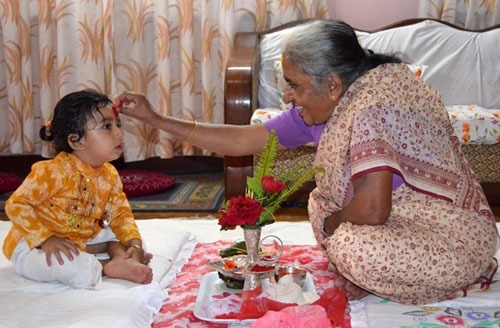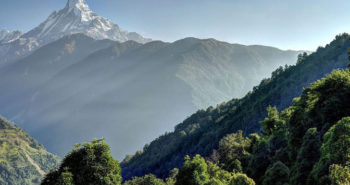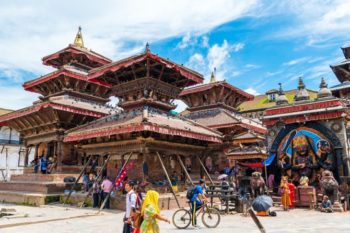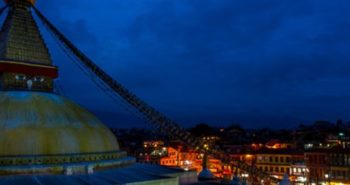Everest Base Camp trek in October
This is one of the best-loved treks in Nepal. Mainly because of the fame of its famous mountain, Mt Everest. And because the name Sherpa means so much to so many people around the world.
Taking you deep into the Nepal Himalayas, the EBC Trek is 12 days of challenging trekking. The rewards, however, are magnificent. Not only will you get to see Everest up close, but you will also see some of the other highest mountains in the world such as Lhotse (4th highest), Cho Oyu (6th highest), Ama Dablam, and many many more.
Aside from the mountains, there are villages and market towns to explore, monasteries to visit, hospitality to enjoy, and friends to make. You will also be flying into one of the highest airports in the world which is a thrill in itself.
Challenging, and strenuous in parts, this trek is not for the beginner. (We have options for those less experienced trekkers.) A good level of fitness is required to undertake this trek. Good gear will also make the difference between a bad or a good trek.
Overview of Trekking to EBC in October
October is a lovely month to visit Nepal and to go trekking in the Himalayas. As a result, everyone will have the same idea! The trails and teahouses (accommodation) will be busy, and flights fill up fast. It is also festival time, throughout Nepal and in the Khumbu (local language for Everest Region). As a result demand for guides and porters is also high because some will head home to celebrate the festival.
There is also a local festival in Tengboche Monastery. The Rimdu Mani Festival held over 15 days, celebrates the founding of Tibetan Buddhism by Guru Rinpoche Padmasambhava in the 8th century. More details are found below. For this festival, there will be an influx of locals and visitors to the area and accommodation will be extremely hard to get in Tengboche, Dingboche, and perhaps even Namche.
In short, October is a wonderful month for trekking but do book well ahead!

Weather and Climate in October in the Everest Region
Most likely the photographs you have seen of the Everest Region have been taken in the autumn season – October and November. This is a lovely time to be in the mountains. The temperatures are around 12oC (53oF) in the daytime in Namche Bazaar, falling to around 2oC (35oF) at night. Colder of course as you go higher, but not too bad at all for the Himalayas
Pros and Cons of Trekking to EBC in October
Definitely, the biggest plus is the weather. Clear blue skies, and not too cold, even at night. After the monsoon season, everything seems fresh and new at the lower altitudes.
The biggest negative is there are lots of other trekkers on the trail. Accommodation and flights may be hard to come by if you leave it too late to book. If travelling solo it will be particularly hard to obtain accommodation. It is well-known in this region to have to share your room with a stranger or sleep in the dining room at this time of year. On the other hand, there are plenty of folks to talk to over dinner and plenty of people on the trails to point you in the right direction.
It is also the start of the autumn climbing season. So, there will be climbing expeditions on route to their base camps. These expeditions will be for several different mountains but there will also be climbers heading to Mt Everest. Which makes it interesting to see at Everest Base Camp.
Preparing for the Everest Base Camp Trek in October
Autumn is less challenging physically than trekking in the winter or monsoon, but you still need to prepare in advance.
Physical Fitness and Training for Everest Base Camp
Step up your normal fitness routine. Don’t have one? Perhaps consider another trek first and work your way up to Everest. But seriously, even if you are young and fit, you should give some thought to increasing your routine to prepare you for the rigours of high-altitude trekking.
Acclimatization and Altitude Sickness
You will have read that acclimatization is a must on this high-altitude trek. You may wonder why. Unless you are living in the Andes, you will most likely be living much closer to sea level than 3,440 m / 11,286 ft. This is the height that Namche Bazaar sits at. It is also around the height (3,000m – 3,500m) when the average person may begin to feel some effects of the altitude, perhaps through a headache. The reason is that there is less oxygen in the air the higher up you go.
It is, for this reason, the EBC Trek has built-in acclimatization days. At Namche Bazaar and at Dingboche. You will find these acclimatization days built into other treks in Nepal and around the world, so important are they.
Without acclimatization, you may develop more than just a headache. You may feel dizzy, unable to sleep and nauseous. If things are not controlled, if the sick person does not follow advice, they can develop high-altitude cerebral oedema and die.
That is the end story. But most likely you will respond to advice and go down to a lower altitude if you feel unwell and wait until you feel good enough to continue. Altitude sickness is such an easy thing to avoid: stay hydrated, don’t travel too fast, and go down to a lower altitude if unwell, and yet its ultimate effects are permanent.
Tips to Avoid Altitude-Related Illness
- Stay well hydrated by drinking plenty of water in the day and evenings. Soft drinks are great but keep up the water too.
- Eat a good breakfast and dinner. If lunch is too much to handle, some granola bars or chocolate and a big bottle of water might get you through just fine.
- Do not go too high without acclimatizing first. Repeat this as a mantra.
- Do not go too fast as it will dehydrate you. Your body will work harder the faster you go and at these heights that is not a good thing and could result in altitude problems.
- Pay attention to any headaches, they may pass quickly or they may be a sign of something more serious.
- It is quite usual to go down to a lower altitude if you feel unwell. Spending the night at a lower altitude very often will make you feel so much better and if it doesn’t, you know there is a problem. Then you seek medical help at one of the health clinics listed below.
- Anyone can suffer from altitude problems regardless of fitness or age.
Essential Gear and Clothing
Here is an all seasons round list of gear. Although it is autumn and relatively warm at lower altitudes it will still be cold at night, in the early mornings and in the evenings.
- Four-seasons sleeping bag
- Trekking boots which you have been wearing before arrival
- Trekking trousers
- Thermal leggings and tops
- Trekking tops that are easy to put on and take off
- Jackets (both down and fleece). It is possible to rent a down jacket in Kathmandu if you do not expect to wear it after this trek.
- Warm socks
- Gloves and a warm hat for the evenings.
- Sun hat for during the day
- Trekking poles
- Sunscreen for the high altitude sun
- Lip balm
- Moisturiser
- Water bottle or flask
- Water purifying tablets or straws for drinking water
- Sunglasses – so much better if they are large and/or wrap around
- Camera
- Whistle (in case of emergencies)
- Medical kit (including extras of your essential medicines in case of delays)
- Personal hygiene kit: toothpaste, toothbrush, shampoo, soap, sponge, towel, toilet paper
- Washing soap for your clothes – why even bother?
- Notebook and pen for journaling, drawing, or doodling when no Wi-Fi
- Phone charger and power pack
Obtaining Permits and Documentation for EBC
You need two main permits to trek in the Everest Base Camp:
Khumbu Pasang Lhamu Rural Municipality Entrance Permit: Nrs 2,000 per person.
Obtainable in Lukla or Monjo. Not available in Kathmandu.
Sagarmatha National Park Entry Permit: Nrs 3,000 per person
The parking permit is obtainable at the Nepal Tourism Board Office in Kathmandu or in Monjo at the gate entrance for Sagarmatha National Park. More convenient at Monjo.
Gaurishankar Conservation Area Permit is required if you are hiking in from Jiri at Nrs3,000 per person. Only obtainable at the Nepal Tourism Board in Kathmandu.
Required documents for trekking permits: you will need a copy of your passport for all. For the Gaurishankar Conservation Area Permit, you will also need to provide two passport-sized photographs. Pay in local currency.
Itineraries and Routes for Everest Base Camp Trek in October
Popular Route Options in October in Everest Region
All the routes in the Everest Region will be open in October. There will be no problem with the trails or high passes.
Trekking with Helicopter Tour in October
If you would like to reach EBC more quickly, there are now options for a 5, 6, 7, 8, 9 days trek with the return journey to Kathmandu by helicopter. October will provide wonderful clear skies and would be the perfect time for treks with helicopter options. It is also the busy season, so if you are interested in doing a shortened trek and returning by helicopter, or in doing the half-day helicopter tour to Everest base camp, definitely book well ahead of time. Don’t leave it till you arrive in Nepal.
Modifications Due to Weather Conditions in EBC in October
No problems on the trails during this season. All trails are open and available!
Major Stops and Highlights Along the Way
This is a busy month but there are still many things to see and do on the trek that you should build into your itinerary. Here are a few ideas.
Spending two nights in Namche Bazaar for acclimatization purposes gives you the opportunity to explore the town and its surroundings.
- Visit the Tenzing Norgay Sherpa Heritage Centre at the Sagarmatha National Park Visitors Centre. Opened in May 2023 to celebrate 70 years since the first summit of Everest, you can gain an insight into both Tenzing Norgay and Edmund Hillary here.
- Drop into the Irish Pub for Guinness, a game of snooker and a good evening out!
- Explore the best bakeries. Please send your recommendations to us!
- If you are here on a Saturday, visit the Saturday market for local goods and handicrafts. We suggest you leave bigger purchases in your hotel until your return trip. Chocolate can definitely go in your day pack!
- Hiking to Khumjung where Hillary set up a school for Sherpa children is a great way to acclimatize (keep moving) and learn some history.
- Go bird-watching for Nepal’s national bird, the Danphe. Something a bit different!
- Hike to Hotel Everest View for a great view of Everest and a cup of coffee!
Meditate in Tengboche Monastery or join the pujas (religious ceremonies) in the morning or evenings. If you are here during the Rimdu Mani Festival you will be extra blessed!
Lobuche is a small settlement at 4,940m/ 16,210 ft. which is the last settlement on the way to base camp.
Everest Base Camp. Take fabulous selfies and photos as proof!
Kalapattar is the best place to get fantastic views of Everest. And even more selfies! Climbing up to the almost 5,500m height is hard but really worth it for the mountain panorama.
Major Highlights of the Everest Base Camp Trek in October
Rimdu Mani Festival in Everest Region in October
Held at Tengboche Monastery, Rimdu Mani is celebrated by the Sherpa community to mark the founding of Tibetan Buddhism by Guru Rinpoche Padmasambhava in the 8th century. Since Sherpa people originate from Tibet, where they were nomadic and eventually moved to eastern Nepal around 600 years ago, they are Buddhist. Today they still follow the Nyingma school of Tibetan Buddhism founded by Guru Rimpoche.
The festival was only first celebrated in the 1900s at Rongbuck Monastery in Tibet and celebrated in the Everest Region after Tengboche Monastery was established in 1916.
While the festival takes place over 15 days, the public, including foreign trekkers, are welcome on the 3 main days.
Day 1 is Wong, or the Empowerment Ceremony. This is the full moon day when the monks form a procession for the arrival of the Rimpoche. Horns, cymbals, and drums are played and accompanied by monks in colourful robes. Locals start to gather, eager to get a blessing and make their own offerings to the monks. One interesting point to note is someone wearing a large mask with a smiling face and white beard. He plays a comic role throughout the festival. He does in fact symbolise that although this festival celebrates triumph over evil, even the simplest among us can participate and be blessed.
Day 2 is perhaps the most interesting as it is the Cham Dances. Otherwise known as masked dances, today the courtyard of the monastery is alive with demons and protectors. In all, there are 15 dances with different stories of the main theme of how Guru Rinpoche spread Buddhism and overcame evil. This is perhaps the most interesting for foreigners to see. And like all Buddhist sites, while being respectful, it is possible to come and go during the day if you need a break from it all.
Day 3 is the Jinsak Fire Puja. In the early morning, there will be offerings in the courtyard: ghee is set in the firewood, the ashes of which are said to be very auspicious. Finally, the mandala that took days to make is destroyed, the sand being taken the next day to be offered to the serpent gods in the river nearby.
The tentative dates for 2023 are 28, 29 and 30 October. Tentative because all Buddhist festivals are celebrated around the lunar calendar. Dates for 2024 are not yet announced.
**If you would like to see this festival, we suggest you book well in advance and mention specifically your interest to attend.
Autumn Expeditions to Climb Mount Everest
There will be climbers coming in to try to summit Everest in this autumn season. The main weather windows will be in November, but Ice Fall Doctors (who fix the ropes), support staff with supplies, and climbers themselves will start coming in from September.
Dashain Festival
Dashain is a major festival that take place throughout Nepal. In 2023 Dashain will take place from 15 to 28 October. As this is when most Nepalis take, what we can compare to annual leave as government offices will be closed, the whole country will be pretty quiet, and many things will be closed. Except for a couple of days before and a couple of days after when everyone moves around and when buses and planes will be full.
What it means for visitors is, it’s a great time to be on a trek in the Everest Region as it is a Hindu festival, not really celebrated by Buddhists. It also means however, that guides and porters may be harder to find if you have not booked ahead as they may also head home if not local to the area.
Since this festival is also dictated by the lunar calendar, in 2024 it will take place over the first two weeks of October.
Other Highlights of Trekking to EBC in October Include:
Standing at 5,545m on Kalapattar to see sunrise or sunset
How will you ever forget arriving at Everest Base Camp? This month you may see climbers also arriving at their own base camp.
Follow the footsteps of the great mountaineers on the trail and in the new Tenzing Norgay Sherpa Heritage Centre in Namche.
Meeting like-minded trekkers in the lodges and on the trails.
Taking fantastic photographs almost at every step of the way.
- The Himalayas. Period.
Accommodation and Logistics in Everest Base Camp in October
Teahouses and Lodges in Everest Base Camp in October
Trekking lodges, or teahouses as they are known in Nepal are family-run and provide accommodation and meals to trekkers and locals alike. At the higher altitudes, they are pretty basic: twin beds, shared bathroom, cold water etc. There are some more comfortable lodges lower down the mountains which are snapped up quickly by luxury groups.
The simple lodges do provide hot showers if you pay for them. Around $3 a time. They also charge for charging your electronics and for boiled drinking water.
Food and Water Availability for Everest Base Camp in October
We suggest you bring enough Nepali rupees to cover your daily intake of drinking water. Around $1 to $2 per litre times 3 to 4 litres a day. The cost soon mounts up. You can bring drops/tablets or a Steripen to make it cheaper for yourself. Use boiled water only when you run out of time or energy.
Food is plentiful on the trek. It might get a bit monotonous as most lodges tend to have the same menu. Nepali, Sherpa (Tibetan), Chinese, Continental. Continental tends to be more like pasta, omelette and toast or some kind of homemade pizza than what you might be used to at home. For lunch, you will eat at the small teashops on the trail. Again, mostly noodles and curry are available. It’s handy to carry some snacks with you.
Beer, some spirits, and cold drinks are available in most places. We recommend not drinking alcohol on a trek. Hangovers, unstable footwork, and stomach upsets are not a good idea.
Hiring a Guide and Porter for EBC Trek in October
If you chose not to trek through an agency, it is usually possible to hire a guide and/or porter once you are in the Everest Region. However, keep in mind this is high season and festival season rolled into one! Demand for such people will be very high. Try to contact and do a firm deal before arriving in the region. Hanging around planes departing from Lukla might be an idea. Or better still, trek through an agency: its safer and takes the strain out of the logistics during this busy time.
Safety and Travel Tips for Everest Base Camp in October
Monitoring Weather Conditions in October at Everest Base Camp
Although the weather in October is pretty good overall, you might want to check it on a regular basis. That’s a challenge. However, National Geographics has set up its own weather centre – the Everest Weather Station Network. This is primarily for very high altitude locations, specifically on Mount Everest itself – designed for mountaineers. You can check the weather through your phone and put the setting to the lowest altitude, 4,000m, to see what the weather is like at base camp and around that height. https://everest-pwa.nationalgeographic.org/
Coping with the Weather and Altitude in October
Above we have given advice regarding altitude. On the whole, please make sure you acclimatize well. This is especially important if you are not travelling with a guide or don’t have pre-booked accommodation in the busy season. While we recommend going down in altitude if you feel unwell, the logistics of finding a bed in the peak seasons when you feel unwell anyway might just be too hard. So, try to avoid getting sick in the first place. Don’t be tempted to push on or go fast. Hydrate well.
Be aware of any headache which could develop into something more serious.
Regarding weather, at this time of year it will not be too cold, but you should ensure you have something extra warm in case the climate does change suddenly. Layers are recommended for every season.
Travel Insurance and Emergency Services for Everest Base Camp in October
Everyone who is planning to trek should be carrying travel insurance. And please read the small print to ensure it covers you to the height you are going, around 5,000m. Helicopter rescues are available, but they will only accept insurance. Or cash if you can possibly carry that much! This climbing season (May 2023) we saw a case of a climber being carried down off Mt Everest with the agreement she paid USD$10,000 to the person carrying her down (no helicopters can land there). At the moment it is all over the media that she is refusing to pay the money. We can assume that somehow she did not have insurance coverage (for climbing Everest!) which took this into account. Always read the small print!
Health Posts Along the Trail
Himalayan Sherpa Hospital, at Phakding, opened in November 2022 offering outpatient and emergency services to locals in its 15 beds. More information can be found here http://www.himalayansherpafoundation.org/project/himalayan-sherpa-hospital-in-phakding/
Himalayan Rescue Association (HRA), is at Pheriche and is manned during the busy spring and autumn trekking seasons by volunteer doctors. Operating since 1973, this non-profit organisation aims to reduce casualties in the mountains. Their main task is to prevent altitude-related deaths among visiting trekkers and among the locals. They give a talk on altitude-related problems every day at 3 pm which you are welcome to attend. Please also donate if you can when you pop in. More information is found here https://www.himalayanrescue.org/
The Mountain Medical Institute (MMI) clinic is found at Namche and Dingboche. Please note the Dingboche branch is closed in the winter months. Staffed by doctors trained in the unique needs of people living and travelling at high altitudes, the clinic in Namche has a basic lab, EKG, and ultrasonography. Call: 985-2850021/ 981-3933179 / 984-1936205.
Any of these health posts will be able to say whether your headache etc is due to altitude or not and recommend you carry on or go down.
Be Responsible
Be a responsible trekker by going slowly, keeping hydrated, and going down if you feel unwell. Do not put stress on others because you were in a rush to reach base camp first!
Embracing the Challenges of Trekking in October
This is a great month for trekking, and the whole world knows it! Enjoy the company on the trails and in the teahouses. Do not complain if you have to sleep in the dining room due to overcrowding. It’s all part of the adventure!
Tips for Trekking Everest Base Camp in October
• Blue skies and warm(ish) days are simply wonderful.
• The mountains are looking at their best this season.
• Regardless of the good weather, stuff happens right? If there is bad weather and your flight is delayed, do not stress too much. No one can do anything about it. Enjoy the extra time in the mountains.
• Same applies if you get sick. Try going down to a lower altitude and hopefully, you feel better. If not, return to Kathmandu with a promise to return next time. The mountains will still be there.
• Planning is extremely important. Dream of a smooth trek but prepare for some ups and downs (and we don’t mean the ground)! Proper gear, proper insurance and work on your fitness level.
• Finally, enjoy yourself.


